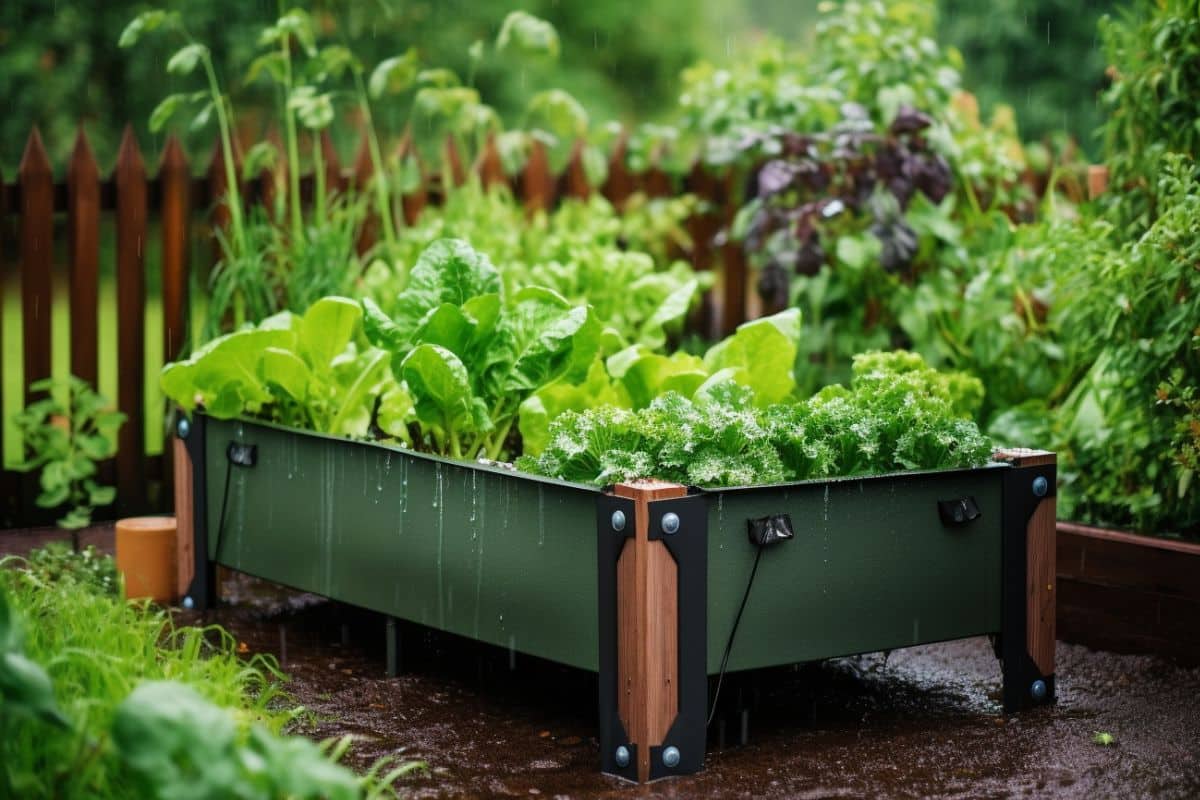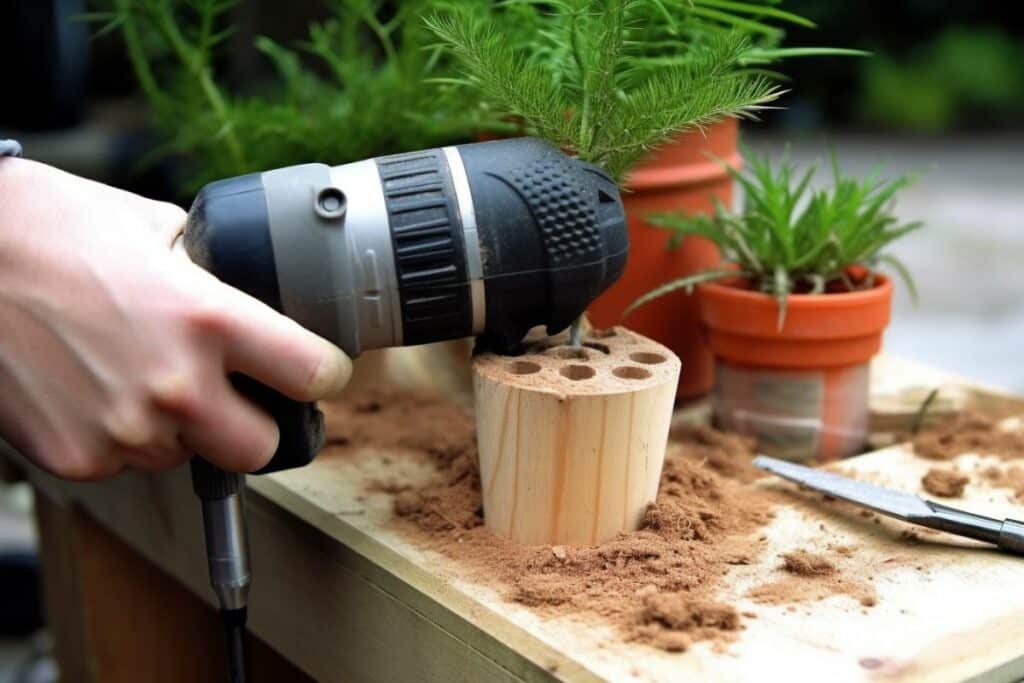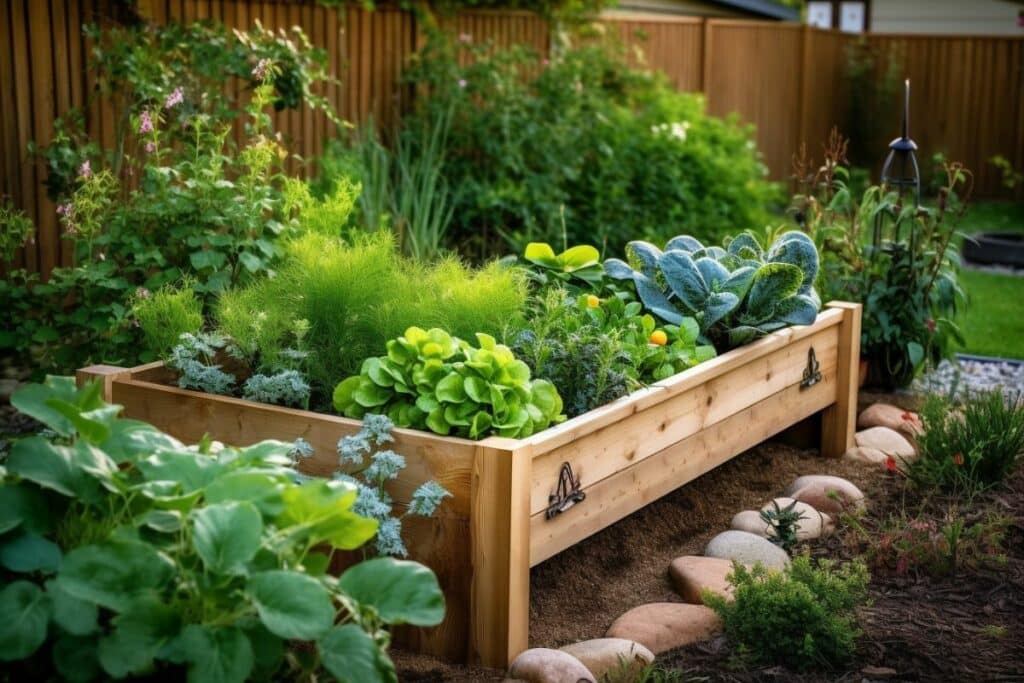Picture this: you’ve invested your time, energy, and resources into creating a beautiful raised garden bed filled with a variety of plants you can’t wait to see flourish.
But then, after days or even weeks of tending to your garden, you notice the soil is constantly wet, and some plants are starting to wilt or suffer from root rot. What went wrong?
The answer likely lies in inadequate drainage – an essential yet often overlooked component of successfully raised garden beds.
In this article, we’ll guide you through the importance of proper drainage for your raised garden bed while offering practical tips and techniques to help you strike that perfect balance between water retention and timely moisture release.
By understanding how soil amendments can improve soil structure and drainage capacity and how drilling drainage holes can boost aeration at the right places, you’ll be well on your way to preventing issues like mold growth and pest infestations.
So let’s dive deep into maintaining optimal soil quality so your lovingly nurtured plants can thrive!
Importance of Proper Drainage

You mustn’t underestimate the importance of proper drainage, as it plays a crucial role in your plants’ overall health and productivity.
Raised garden bed drainage holes are essential for maintaining an ideal balance between water retention and water drainage to ensure healthy plant growth.
By effectively managing soil drainage, you can prevent root rot, mold, and pests that thrive in damp conditions. To achieve proper drainage in your raised garden beds, start by carefully choosing the appropriate materials and design elements for both the bed structure itself and the soil mixture within.
This includes selecting a suitable base material with holes or gaps to allow excess water to escape easily while still retaining adequate moisture for your plants’ needs.
Additionally, use high-quality soil mixtures that promote improved air circulation and water flow through the root systems.
As you continue to maintain excellent raised garden bed drainage systems, you’ll notice significant improvements in your plants’ vitality, resilience against diseases, and overall yield potential. So don’t neglect this vital aspect of gardening – good drainage is fundamental to a thriving garden ecosystem!
With these factors in mind, let’s now explore how soil amendments and aeration techniques can further enhance the performance of your raised beds.
Raised Garden Bed with Self Watering Planter Box
Very Efficient Raised Garden Bed
Benefits:
- The planter’s dimensions are 32.3 in. L x 14.7 in. W x 30.7 in. H, perfect for urban living such as herb gardens or balcony planters.
- It features an easy-to-read water gauge which clearly indicates when plants require more water.
- The integrated drainage system can be opened or closed, providing full control over watering.
- Its comprehensive watering system includes a water reservoir to prevent root decay and overwatering, and it offers simple assembly with easy-to-follow instructions.
Soil Amendments and Aeration
It’s time to channel your inner alchemist and dive into the world of soil amendments and aeration to master the art of drainage in your elevated Eden.
Soil amendments are materials added to the soil that work to improve its overall structure, nutrient content, and water retention capabilities. By incorporating these magical mix-ins, you can transform even the most stubborn and compacted earth into a playground for thriving roots, ensuring good drainage and healthy plants.
Here are four fantastic soil amendments that will help improve soil drainage in your raised garden bed:
- Perlite: This lightweight volcanic rock is often used in potting mixes because it increases air space within the soil while also improving drainage.
- Vermiculite: Similar to perlite, vermiculite is another mineral-based amendment that adds air pockets within the soil structure for better water management.
- Bark or Wood Chips: Organic materials like bark or wood chips can break up heavy clay soils by adding texture and improving aeration.
- Coarse Sand: Mixing coarse sand into your garden bed can help alleviate soil compaction by creating larger pore spaces between particles for water flow.
The secret ingredient in all this transformative magic? Earthworms! These wriggling wonders not only aerate the soil by creating tunnels as they move through it but also generate nutrient-rich castings that further enhance your garden’s growing potential.
So don’t be shy about inviting these slimy guests to join you on your journey toward raised bed mastery.
With improved soil structure from carefully chosen amendments combined with industrious earthworms working tirelessly beneath the surface, you’ll soon have an oasis of optimal drainage where plants thrive.
Now that you’ve conjured up a superior growing medium with excellent moisture management properties let’s discuss how drilling drainage holes at the bottom of your container plays an essential role in preventing root rot and other soggy-soil-related issues.
Drilling Drainage Holes

Don’t underestimate the power of drilling drainage holes at the bottom of your container – they’re crucial for keeping those plant roots healthy and happy.
In a raised garden bed, proper drainage is essential to prevent waterlogged soil that can suffocate plants and provide an environment for mold, fungi, and pests.
Drilling drainage holes in the bottom of pots will not only help improve drainage but also ensures adequate airflow to support root health.
When drilling drainage holes in your raised garden bed, consider the size and number of holes needed based on the size of your container and the type of plants you’re growing. Smaller containers may require fewer holes, while larger beds might need more to ensure effective water flow.
It’s important to place these holes evenly across the bottom surface so that excess water can escape uniformly without causing pooling or uneven soil moisture levels.
As you plan your raised garden bed setup, remember that achieving adequate drainage goes hand-in-hand with other factors, such as selecting appropriate soil amendments and creating a hospitable environment for earthworms.
By taking these steps together, you’ll create a well-draining yet moisture-retentive space where your plants can thrive.
With this foundation laid, it’s time to explore how you can strike just the right balance between ensuring sufficient drainage while retaining enough moisture for optimal growth in your raised garden bed setup.
Balancing Drainage and Retention
Striking the ideal balance between sufficient drainage and proper moisture retention in your raised garden setup is essential for cultivating healthy, flourishing plants.
Both overwatering and underwatering can lead to poor plant health and growth, so it’s crucial to find the sweet spot that allows for enough water to be retained while also ensuring excess water drains away efficiently.
To achieve this delicate equilibrium in your raised garden beds, there are several factors you should consider:
- Select a soil mix that promotes good drainage and moisture retention. A well-aerated potting mix containing organic matter like compost or aged manure, along with amendments such as perlite or vermiculite, will help regulate both drainage and water retention.
- Install an effective drainage system. Incorporate weep holes or slotted PVC pipes at the base of your raised garden beds to facilitate excess water escape without losing valuable nutrients.
- Monitor and adjust watering practices. Tailor your watering regimen based on plant needs, local climate conditions, and soil quality. Observe how quickly the soil dries after watering to ensure proper drainage.
By maintaining a close eye on these aspects of your gardening routine, you’ll be better equipped to strike the perfect balance between keeping your plants well-hydrated and preventing them from becoming waterlogged.
Remember that each raised garden bed may have unique requirements depending on its size, location, materials used in construction, and type of plants grown within it.
As you become more familiar with your specific setup’s nuances, make adjustments as needed to optimize both drainage capacity and moisture retention.
This attention to detail will benefit your plants’ overall health and help prevent future issues such as mold growth and pest infestations – which we’ll discuss further in our next section about preventing mold and pests in raised garden beds.
Preventing Mold and Pests
Nipping mold and pests in the bud can be a breeze when you take proactive measures to keep your flourishing oasis healthy and well-drained.
When it comes to raised garden bed drainage, preventing mold and other harmful organisms from taking root is essential for maintaining the overall health of your plants.
By ensuring that your soil has the proper drainage capacity, you’re not only providing an optimal environment for plant growth but also minimizing the conditions that encourage mold and pest infestations.
One effective way to improve raised garden bed drainage is by incorporating landscape fabric into your design. This permeable material allows excess water to drain away while keeping soil in place, reducing the chances of standing water which promotes mold growth and attracts pests like slugs or snails.
Additionally, using high-quality soil amendments such as perlite or vermiculite can help improve soil structure, allowing for better air circulation around plant roots while retaining adequate moisture levels.
Another important aspect of preventing mold and pests in your raised garden beds is paying attention to how often you water them.
Overwatering can lead to damp conditions that encourage fungal growth and attract unwanted critters. To avoid this issue, make sure you’re only watering when necessary based on factors like weather conditions, plant needs, and the type of soil used in your beds.
Keep an eye out for any signs of poor drainage or mold growth so you can address them promptly before they spread throughout your garden.
With these thoughtful steps in place, you’ll be well-equipped to handle any challenges that come with maintaining soil quality in raised garden beds without compromising their health or beauty.
Maintaining Soil Quality

It’s essential to keep your soil in top-notch condition, as this will ensure the health and vitality of your plants while also preventing common issues like poor drainage, mold, and pests.
Maintaining soil quality is crucial for proper raised garden bed drainage. One way to achieve this is by preventing soil erosion, which can occur when water washes away the topsoil layer, leaving behind a compacted layer that prevents proper drainage. To prevent soil erosion:
- Plant cover crops during off-seasons or use mulch to protect the soil surface.
- Create borders around your raised beds with materials like stones or wood.
- Avoid overwatering and practice proper watering techniques.
Another important aspect of maintaining soil quality is amending your native soil with different soil amendments.
Adding organic matter such as compost, aged manure, or leaf mold can improve both the structure and nutrient content of your native soil while also aiding in improved drainage capacity.
In addition to organic matter, you may need to add other amendments like perlite or vermiculite for better aeration and water retention balance.
As you continue tending to your raised garden bed, it’s important to consistently monitor its overall health. Observe how well plants are growing and adjust watering practices if necessary. Keep an eye out for signs of pests or diseases so that you can address them promptly before they become bigger problems.
By staying vigilant about maintaining the quality of your soil and finding ways to improve raised garden bed drainage as needed, you’ll be on track for a thriving gardening experience that supports healthy plant growth without any unnecessary challenges from poor draining soils or unwelcome pests.
Conclusion and final thoughts ?
So, what’s the secret to perfect raised garden bed drainage? You’ll have to keep a close eye on your soil, make amendments as needed, and stay proactive with maintenance.
Your plants will thank you for it! Remember, finding the right balance between drainage and water retention is key. Ever wonder what a rain garden is?
With dedication and attention to detail, you’re well on your way to unlocking the full potential of your raised garden bed. Happy gardening!
